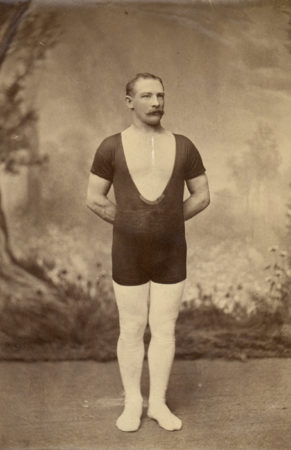Edwin Bibby Defies Old Adage
One of the oldest adages in combat sports is “a good big man always beats a good little man”. It is the reason that we have weight divisions in boxing, wrestling and mixed martial arts. On Tuesday, November 2, 1881, 160-pound Edwin Bibby proved there are exceptions to this rule.
While small, Edwin Bibby was particularly strong for his size. Picking up the sport quickly, Bibby became a top wrestler in England. He wrestled in front of Queen Victoria in London’s Prince Albert Court. Bibby realized more opportunities were available in America, where prizefighting was still illegal. Professional wrestling provided the only legal combat sport for American fans.

Edwin Bibby in 1884 from the Public Domain
Most of the American wrestlers were larger than Bibby, so the American wrestling fans were initially slow to recognize Bibby’s quality as a wrestler. He didn’t “look the part”. However, Bibby would prove that big muscles don’t necessarily mean wrestling skill.
To demonstrate his superiority, Bibby toured the country looking for the biggest men he could wrestle. While smaller, Bibby was confident his superior skill with good conditioning would allow him to best all these opponents. One of those challengers was William Heygster. Heygster was a European not American but definitely fit the larger part.
While Heygster was only 5’07” tall, he weighed 260 pounds, a full 100 pounds more than Bibby. Heygster possessed a 54″ chest and 57″ waist. He was also about 50 years of age. Bibby was much younger but only stood 5’04”.
Heygster also claimed to be a Greco-Roman wrestling champion in Germany. I doubt this claim is valid. Many lightly regarded European wrestlers travelled to America in the 19th Century and claimed to be champions back in Europe. With travel and media being much slower than today, it was impossible to verify, or more importantly for the claimant, dispute these credentials.
When the match started, Heygster’s great size did prove a challenge for Bibby. Bibby tried to twist Heygster’s arm with a wrist hold. Heygster laughed as Bibby’s grip slipped before grabbing Bibby’s forearms with his own hands.
Bibby worked his hands free and grasped the back of Heygster’s neck with both hands. The position is similar to a muay Thai clinch. Bibby used the position to try to twist Heygster to the ground. Heygster planted his feet and successfully withstood all of Bibby’s efforts.
After fifteen minutes, Heygster started to breathe heavily. Heygster realized that he was quickly fading, so he tried to catch Bibby for a fall. Heygster secured a waist hold, lifted Bibby to shoulder height and tried to slam him for a fall. However, Bibby worked free and again secured his hands around the back of Heygster’s neck.
As the ringside spectators noticed Heygster’s breathing was becoming erratic, Bibby pulled him from side to side by his neck. Finally, Bibby was able to throw Heygster onto his side. Using a half-Nelson, Bibby wrenched Heygster onto his shoulders. The referee signaled the first fall at 23 minutes.
The men took a 17-minute break between rounds but it wasn’t enough for the German grappler. At the start of the second fall, Bibby slid his right arm under the giant’s left armpit, tossed him over his hip and pinned him in 1 minute. Bibby proved that a small but great wrestler can beat a large but average to good wrestler. How would Bibby do against a larger and great wrestler though?
You can leave a comment or ask a question about this or any post in the comment section below or on my Facebook page or Twitter profile.
Source: Daily Globe (St. Paul, Minnesota), November 7, 1881 edition, p. 2
Pin It
